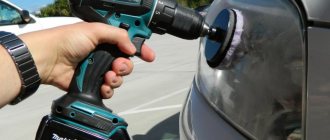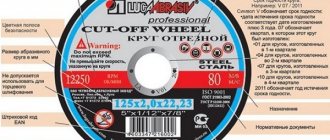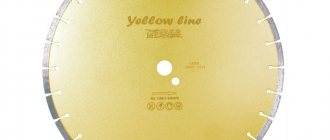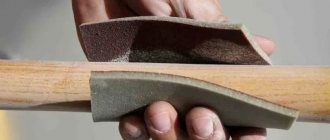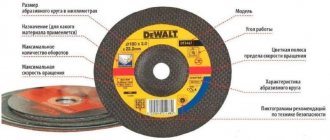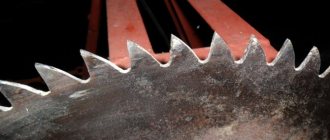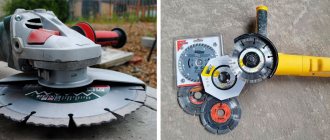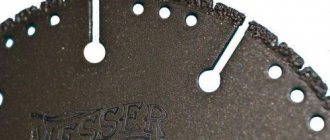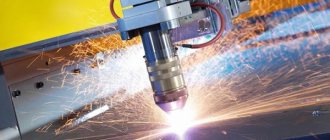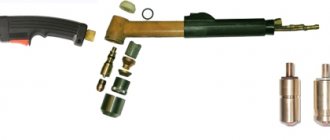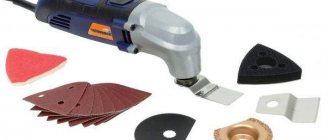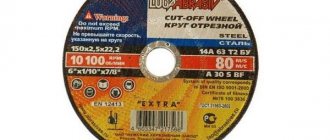Types of discs for grinders
Diamond blade - For the manufacture of such disks, diamond-coated steel is used. It can cut any metal, cut various types of natural stones and artificial stones.
A diamond blade can be used to cut glass and ceramics. It is important to make several shallow cuts when working. This circle cut is narrow and neat.
There are new polishing wheels on sale; they have an elastic base. The new items have a non-smooth surface that resembles a turtle shell, hence the name: “Turtle”.
Carbide disc - Discs are made from high-alloy steel with the addition of chromium, nickel and molybdenum. The successful combination of these metals with steel gave this type of disc mechanical strength, thermal strength, and resistance to corrosion and oxidation. I mainly use carbide blades to process aluminum, high-carbon steel, and sometimes wood.
Abrasive disc (fiber wheel) - In the production of this type of disc, the basis is latex paper or fiber. An abrasive material, such as aluminum oxide or silicon carbide, is applied to such a base. The abrasive disk is connected to a support plate; it is needed to stop the cooling of the abrasive.
These discs are used both for cutting and for stripping and stripping. The fiber wheel is suitable for any material: iron, wood, stone, concrete. They can remove old paint, scale and even carbon deposits from any surface.
Standard disk sizes
The sizes of discs for grinders are standardized. The table shows the main technical characteristics of attachments for grinders:
| Outer diameter, mm | Thickness, mm | Bore diameter, mm |
| 115 | 1,0; 1,6; 2,0; 2,5; 3,0; 3,2 | 22,00; 22,23 |
| 125 | 0,8; 1,0; 1,25; 1,6; 2,0; 2,5; 3,0; 3,2 | 13,20; 22,23 |
| 150 | ||
| 180 | 1,0; 1,25; 1,6; 2,0; 2,5; 3,0; 3,2; 4,0 | 22,23; 32,00 |
| 230 | 1,6; 2,0; 2,5; 3,0; 3,2; 4,0 |
The dimensions of non-standardized circles may differ from those indicated in the table if they are manufactured according to the manufacturer’s specifications.
Cutting discs
Cutting discs, or they are also called abrasive discs, are most often used for grinders. Electrocorundum or silicon carbide of different sizes and hardness are used as abrasive grains. Nozzles are available in bakelite (with and without reinforcing elements) and vulcanite bond, flat and with a recessed center. The latter type cuts metal with an emulsion, since it has a low degree of heat resistance and cannot work under increased loads. Discs differ according to the material they can work with. The marking of such products contains an inscription and color. Explanation of the inscriptions in the table:
| Inscription | Purpose: for cutting |
| Metal | metal |
| Сoncrete | concrete and stone |
| Steel | become |
| Aluminum | aluminum, non-ferrous metals and alloys |
| Inox | stainless and high alloy steel |
| Castiron | castings and cast iron |
If there is a blue stripe on the disk, then the circle is intended for working with metal, and green for working with concrete.
The circle markings are clearly shown in the figure.
Products made with vulcanite binder operate at speeds from 50 to 80 m/sec, with bakelite binder – from 80 to 100 m/sec.
The disc itself indicates the date until which it can be used, i.e. the expiration date. If it is on a vulcanite bond, then this period does not exceed 1 year, on a bakelite bond - 6 months.
Grinding wheels
The products belong to the group of abrasive materials and are used before preparing the product for grinding, to clean contaminated surfaces and tarnished colors on metal.
They consist of an abrasive substance and a binder. Available in hard and flexible. In the first case, a binder of bakelite, vulcanite or ceramic is used, in the second - based on rubber. The degree of surface cleaning depends on the grain size. A distinctive feature of the grinding wheels is that they have the same seat diameter, equal to 22 mm. They are available in outer diameters of 115, 125, 150, 180 and 230 mm and thicknesses from 3 to 20 mm.
This group of products includes cord brushes, the working surface of which is metal wire. The products are called twisted cutters and come in cup-shaped and disk-shaped.
Sanding discs
Products in this group allow you to grind with the required degree of roughness on metal and wood.
The grain size plays an important role. The finer the grain size, the higher the quality of the sanded surface. Manufacturers produce wheels with the following grain sizes: 50, 100, 200, 400, 600, 800, 1000, 1500, 2000, 3000. Consumables can be made of emery, have a sponge, felt, felt or fabric surface. The felt wheel is used to perform polishing operations on grinders that are equipped with a speed control device. Products are made from coarse or fine wool of sheep, cows, goats, and camels. The diameter of such circles is from 50 to 150 mm, and they are 25 or 30 mm thick. It is recommended to polish at the speed specified by the consumable manufacturer.
Grinding wheels
Using sharpening discs, the edges of cutting tools are brought into working condition, and weld seams are also cleaned. Available in flat and cup-shaped. A distinctive characteristic of such products is their thickness, which is at least 5 mm.
Each type of work has its own disk
It is important to use your own disk for each type of work. Cutting wheels cannot be used for stripping and vice versa. Based on this, it is possible to divide the types of disks by type of work.
- If it is necessary to cut or saw, then use cutting discs.
- If you have to cut wood products, use saw blades.
- If you need to peel off old layers of paint and varnish materials and primer or make the surface smooth, you need a roughing or grinding disc.
- You can process metal, wood, and plastic products with a flap disc.
- For final polishing of surfaces, a polishing disc is best.
Types of discs and attachments for grinders according to the nature of the work
Depending on the type of work performed, grinder wheels can be cutting, sawing, roughing, scraping, flaping, polishing, and there are also discs for cutting seams.
Discs for grinders are sawing, cutting, roughing, flap, scraping, polishing
Cutting wheels make cuts and rough cuts of various materials, which is performed due to the presence of cutting edges. The disk itself has a solid circle or is divided into segments.
A saw blade for an angle grinder is a type of cutting wheel. It is designed for cutting wood products. Thanks to the presence of teeth on the cutting edge of the product, it is possible to carry out a clean and even cut of solid boards, parquet, plywood and drywall. The 125 mm wood saw blade for an angle grinder can be used for fiberboard, chipboard and laminate. Using a saw wheel, you can select grooves in gas silicate.
Peeling attachments for grinders are designed to remove old paint, primer, and varnish from the surface. This attachment is used to grind the workpiece. Discs are available in standard diameters and thicknesses of 3-20 mm.
An angle grinder can be used to cut joints in asphalt, concrete and stone, which is made possible thanks to a special attachment for an angle grinder. To polish the surface, use a special emery disc or attachment with a felt or felt wheel.
Using a concrete disc you can cut joints in asphalt, concrete and stone
Cleaning attachments: petal discs for grinders and coral circles
A type of grinding wheel is a grinding disk for an angle grinder, which is presented in the form of a metal disk brush. This nozzle is designed to remove rust and other stubborn contaminants.
A coral disc is used for delicate processing of metal workpieces. It is made of synthetic fiber material in the form of fiberglass. This elastic structure of the nozzle gently cleans the metal surface, penetrating deeply into its structure without destroying its integrity. This device is most in demand in car repair work, where it is used to remove paint and varnish from a car body without damaging the metal layer. The material being cleaned does not clog the porous base of the disc.
Flap wheels for grinders are also classified as cleaning attachments. They are used for processing wood, plastic, and metal products, for removing rust, cleaning welds and burrs. The petal circle is a plate fixed around the circumference with an overlap - according to the principle of a petal flower.
There are several types of petal nozzle, which are represented by an end-face, a package product and a circle with a mandrel. The end disc is designed for normal flat or angled machining. It can be straight or tapered. The first option is used for sanding large surfaces, and the second is necessary for finishing seams and joints.
The cleaning disc for an angle grinder is a metal disc brush.
The stacked flap disc is designed for sanding large areas. When working with cavities, a grinding wheel with a mandrel is used, thanks to which maximum precision in processing the workpiece is achieved.
Metal discs
Cutting wheels for working with metal are made from a super-hard material that is chemical-resistant and extremely fire-resistant based on aluminum oxide.
Cutting wheels made from these materials can be of two types:
- Flat;
- Convex.
Discs with a convex center are used for cutting metal products very close to the wall.
Grinder discs: characteristics of the cutting wheel
The most popular type of disc for an angle grinder is the cutting attachment. It is represented by a circle with a hole inside, which is reinforced with a special metal ring to securely fix the element on the angle grinder spindle.
There are two types of cutting wheels - abrasive and diamond. Particles of abrasive material are applied to the working surface of the first version of the disc, which are connected to each other using a binder. A reinforced mesh made of synthetic material is applied on top of such a coating, thanks to which the strength properties and safety of using accessories for an angle grinder are increased.
Important! During operation, the surface of the disk gradually wears off, so an attachment with wear of no more than 35% is suitable for effective operation.
The most popular disc for an angle grinder is considered to be cutting
The abrasive disc has an affordable price. Grinder wheels come in a wide range and can be used for working with metal, wood and stone. However, the disc wears out quickly. This is accompanied by the emission of sparks during its operation, which can cause a fire. When working with a metal cutting disc for an angle grinder, an unpleasant odor arises, which takes a very long time to dissipate, making the tool inconvenient to use indoors.
How to choose an abrasive cutting disc for an angle grinder
Abrasive chips have a certain level of grain size and hardness, which determines the quality of surface treatment. It can be formed from various materials, as evidenced by the product labeling. Zirconium alumina (“A”), electrocorundum (“AS”), or silicon carbide (“C”) can be used as an abrasive.
Grinder discs are available in sizes 115-230 mm (diameter), their thickness is 1-3.2 mm. The inner ring size is 22.2 mm. The size of the circle is selected depending on the type of tool.
Helpful advice! The most popular option, which is intended for household work, is a universal metal cutting disc for an angle grinder 125 mm.
Abrasive cutting discs for grinders have a diameter of 115-230 mm and a thickness of 1-3.2 mm
The choice of disk thickness depends on the type of metal. For aluminum and thin steel, a circle measuring up to 1.5 mm is used. For reinforcement and dense metal products, it is advisable to use a disk with a thickness of more than 2.6 mm.
Based on the characteristics of the disc, we can say that the smaller the thickness of the cutting wheel, the faster the cut, since the small area of the blade helps reduce its resistance. Thin bits heat up less and provide a smoother and cleaner cut, but such discs wear down faster.
Helpful advice! Thin disks are best suited for low-power angle grinders that are not designed for long-term operation.
Differences between cutting discs for metal, wood and stone
Cutting attachments are classified according to the type of material being processed. There are discs for grinders for stone, metal and wood. The first two options are no different in appearance. To choose the right consumables, you need to carefully consider the markings.
The cutting disc for concrete has a coating of diamond chips on the cutting edge
The differences between discs are the type of abrasive used and the composition of the base wheel.
Cutting discs for metal 125 mm (and other standard sizes) are manufactured in several stages. Initially, the process of mixing the resin with the base substance, which is used as cobalt, electrocorundum or diamond, occurs. Then special additives are added to the composition. The finished mass is poured into the mold. A galvanized steel ring is placed in its central part. The edge of the disk is reinforced with fiberglass mesh. The mold is placed in an oven, where the product hardens under high pressure for 24 hours.
Important! The surface of the disc for the grinder for metal 125 (and other sizes) is blue.
The grinder disc for concrete and tiles is made in the same way as for metal. There are options made of galvanized steel. A special feature of the products is the presence of a circle of diamond chips on the cutting edge. The abrasive size varies between 0.2-0.8 mm.
Cutting discs for wood can be either toothed or chain
Woodworking discs have fine teeth and a sharp edge along the entire rim of the product. The edge is coated with tungsten carbide. The teeth can be straight, beveled or trapezoidal. The first option is used for pine needles and soft woods. The last type of product is used for processing medium-density material. A disc with alternating beveled teeth is a universal option.
Wood discs
Toothed or circular discs are installed on permanently mounted “grinders.” A special feature of such a disc is the presence of teeth on the outside tipped with carbide materials.
There are chain discs, they have a chain. Suitable for medium density wood. When working with such a wheel, you cannot cut wood with metal elements; the chain will quickly become dull when it comes into contact with them. Everything is like with saws.
Sometimes you need a blade that can cut all types of materials - this is a universal blade. The nozzle has the appearance of a regular disk with three additional teeth, tipped with hard metal.
The disc with a tungsten carbide edge has tungsten carbide coating on the outside. There are technological holes on the disk, they help remove heat during operation. This disc is suitable for wood and plastic. Working with such a disk makes it easier to encounter various metal objects, such as screws.
Disc care and storage
The discs do not require any specific care procedures. The only condition is to remove them from the grinder at the end of the work. It is believed that the quality of the tool is affected by atmospheric humidity - the higher it is, the worse the performance of the attachments will become. This is true, but we must take into account that for a noticeable deterioration in the condition of the disks, they must be stored in poor conditions for a long time.
Typically, nozzles are kept on special stands, where they are not protected from atmospheric air in any way. Organizing high-quality ventilation of the room, or at least regular ventilation of the workshop, will help here. However, most often the nozzles are completely worn off and simply thrown away. If there are several unused disks, it is easier to place them in a plastic bag and thereby cut off the access of airborne moisture to the instrument.
Did the article help you understand discs for angle grinders?
Of course! Not really
The number of varieties of attachments for angle grinders is very large. They differ in certain characteristics:
- Purpose
- Design
- Size
- Manufacturer
When choosing a disk, you should take into account the type of material to be processed, the specifics and volume of the work to be done. More expensive professional attachments are designed for long-term processing of large quantities of parts. For small occasional jobs, inexpensive attachments are usually chosen, which are quite enough to solve small problems.
The purpose and other parameters can be found out from the markings applied to the surface of the disk or supplied as a separate label. When working, you should follow all operating and safety rules, which will increase the service life of the disks and avoid injuries and damage.
Stone discs
Stone cutting discs, also known as diamond discs, are used for cutting all types of stones. There are several types of discs with applied diamonds.
- Solid Discs - There is a continuous tape on the disc. Diamonds of non-natural, artificial origin are applied along the entire circumference of the tape. The disc is designed for high-precision cutting.
- Segmented discs - The disc has several technological holes or slots, this increases resistance to mechanical and temperature loads.
- This type of drive is more productive. The disc is designed for rough, not precise cutting.
- Turbo discs - To increase mechanical strength, improve heat dissipation and increase cutting speed, the disc has grooves on the sides of the rim. The disc cuts any mineral materials.
- Turbo segmented discs - Discs are characterized by high performance and versatility.
- Diamond blades differ not only in structure, but also in the cutting method. Can be dry cutting and wet cutting.
- Dry cutting - This method provides a more precise cut. But its disadvantage is a large amount of dust. This type of work requires good ventilation.
- Wet cutting - This kind of cutting involves water cooling due to a constant flow of liquid. The disadvantage of such discs may be the bulkiness of special equipment for supplying liquid.
Characteristic features of a diamond cutting disc for an angle grinder
A diamond cutting wheel is a steel disk with a cutting part coated with diamond chips and expansion grooves over its entire area. They act as teeth, thanks to which heat is removed and deformation stress is reduced. The slots are located strictly symmetrically, which eliminates vibration of the disc during operation. The mass of diamond chips is also balanced in diametrically opposite directions, which ensures high quality and uniform cutting.
Diamond particles are interspersed throughout the rim of the circle. They cover a rim made of zinc, tin, nickel or cobalt alloys. The way the diamonds are secured determines the purpose of the wheel. Using galvanic technology, such discs are designed for processing products made from soft natural stone. If laser welding or sintering is used, the wheel can be used for any type of solid material.
A diamond blade for a 125 mm grinder and other standard sizes can have a surface grit from 50 to 3000.
A diamond blade for an angle grinder can have a surface grit from 50 to 3000
A diamond disc has a number of distinctive advantages over a simple abrasive wheel. It has greater productivity, durability, performs high-quality and accurate cuts and shows long service life. When working with it, no sparks are formed and there is no strong odor.
Important! The diamond blade can be used on angle grinders with a speed of 12,000 rpm, but can also withstand 13,900 rpm, which is typical for professional machines.
This circle is afraid of overheating, so you need to take breaks when working with it. When using a non-segmented diamond blade for an angle grinder of 230 mm and smaller diameter, it is necessary to provide additional cooling with water. The disadvantage is also the high price of such consumables.
What types of discs are there with diamond chips on the surface?
For a cut diamond wheel for an angle grinder, monocrystalline (in the form of solid spatial structures of regular shape) or polycrystalline diamonds, which consist of several small single crystals firmly connected to each other, can be used. Concrete discs for grinders of 230 mm and smaller diameter, equipped with the first type of material, can be used for cutting hard materials, since they are more durable.
The surface of diamond wheels for grinders has different colors, for example, orange ones are intended for plaster and brick
Important! A diamond blade for a grinder for concrete can be used to make a straight cut, since with a curved trajectory the disk can lose diamonds or be destroyed completely.
The artificial diamonds on the rim of the disc can be evenly distributed or spaced at specific intervals. The last option is more productive. Such discs provide less force on the tool, promote uniform load distribution and more efficient cooling.
The outer surface of diamond grinder wheels can have different colors. Based on the decoding of the disc colors, blue frames have nozzles for concrete and marble, gray frames for ceramic products, green frames for granite, yellow frames for ceramics and plaster, orange frames for plaster and bricks.
Classification of diamond discs for concrete for grinders depending on the structure
Diamond wheels are primarily designed for working with non-metallic materials. They are used for cutting ceramics, concrete, glass, asphalt and brick. There are also diamond blades for metal grinders that can process thin material.
Segmented diamond blades have equal sized dividing slots
Diamond bits differ in structure, depending on which they are divided into solid, segmented, turbo and turbo-segmented. The first type of wheel is equipped with a continuous cutting band, which is located around the circumference. There are several rows of artificial diamonds on it. Such discs are used for grinders on tiles, ceramics and other materials for which precision cutting is important.
Segmented wheels have dividing radial slots of the same size in several working areas. This type of diamond disc is more resistant to temperature and mechanical loads and provides greater productivity. However, the cut is not as precise as when working with solid discs. In addition, they have a higher cost. This attachment is designed for deep cutting of concrete structures.
A distinctive feature of diamond turbo discs is the presence of oblique notches on the sides of the rim, which increases the mechanical strength of the wheel. It also helps to increase the intensity of heat removal, which allows you to speed up the cutting process by 75-100%. The turbo disc can be used to quickly cut various mineral materials of varying hardness.
The most productive discs are turbo segmented discs. The rim is divided into segments with a lateral turbo notch.
The presence of oblique notches on the sides is a distinctive feature of turbo discs
Diamond blades for grinders for concrete are also distinguished by method of use - for wet and dry cutting. The first type of product has a continuous solid surface. Before starting work, it should be moistened with water. When making a disc, bronze or cobalt is applied to its cutting edge. The first option is used for cutting granite and quartz, and the second is used for tiles and drywall.
Dry cutting discs have a surface divided into several segments around the entire perimeter. Diamond teeth are welded to the end of each strip. This circle exhibits increased resistance to overheating. Despite this, it should not be operated for more than 3 minutes. This blade is designed for cutting rock and concrete materials.
Grinding disc
Grinding discs come in a variety of shapes: flat and cup-shaped; by surface type: petal, wire, diamond, disc.
- Flap disk - used when working with wooden surfaces.
- Wire disc - used for stripping or removing rust.
- A diamond blade is good when working with stone. When working on stone or similar surfaces, use a bowl-shaped wheel.
- Disc disc - for grinding metal.
Advantages and disadvantages
The advantages of discs for angle grinders include:
- Wide selection of varieties and sizes.
- Availability, low cost of most models.
- High performance.
- Reliability of the design, durability of the nozzles.
- Ability to work at high speeds.
- Resistance to mechanical loads, the ability to withstand light impacts or pressure during operation.
The disadvantages of discs for angle grinders are:
- Relatively rapid wear of working edges or surfaces.
- When cutting metals, sparks are generated that can damage surrounding objects.
- The smell of burnt material from cutting attachments is unpleasant and requires ventilation.
- Inexpensive discs are not strong enough; sometimes they fall apart during operation, which is dangerous for the master and others.
Expert opinion
Kuznetsov Vasily Stepanovich
A serious disadvantage of cord brushes is the possibility of individual wires flying out and piercing into surrounding objects at high speed. If a person is hit, serious injuries can occur, so safety precautions should not be neglected.
Instructions for replacing a disc on an angle grinder (step by step)
No matter how durable the circle is and is resistant to all kinds of influences, sooner or later it will need to be changed. Replacing a disk consists of several stages:
- Disconnect the grinder from the power source.
- Press the button that locks the spindle.
- Insert the key with the pins into the nut that secures the circle.
- Turn the wrench counterclockwise until the nut gives way. In this case, do not forget to hold the latch. As soon as the nut starts to move, you can tighten it by hand.
- Remove the nut from the spindle, then remove the used disc.
- Now you can safely put on the new disc.
- We perform all steps in reverse order. The nut does not need to be tightened with a wrench; it is enough to fix it manually.
- We plug in the tool and continue working.
How to unscrew a disc on an angle grinder if it is jammed
During operation, for one reason or another, a nuisance may occur - the disk may jam. We offer you two ways to solve this problem:
First way
- We find, in our arsenal, a piece of metal plate no more than 1 mm thick.
- Clamp the plate in a vice.
- Break the remaining disk. It's better to use pliers.
- We insert the plate between the upper nut, the one that secures the disk, and the lower nut.
- Let's start cutting.
- The remains of the disk between the nuts will wear off, and the nut will begin to move freely.
- Remove the nut
Second way
- We break the disk.
- Using a gas wrench, fix the lower nut so that the spindle does not rotate.
Using a standard wrench, we begin to unscrew the top nut. As soon as the top nut moves out of place, you can unscrew it by hand.
